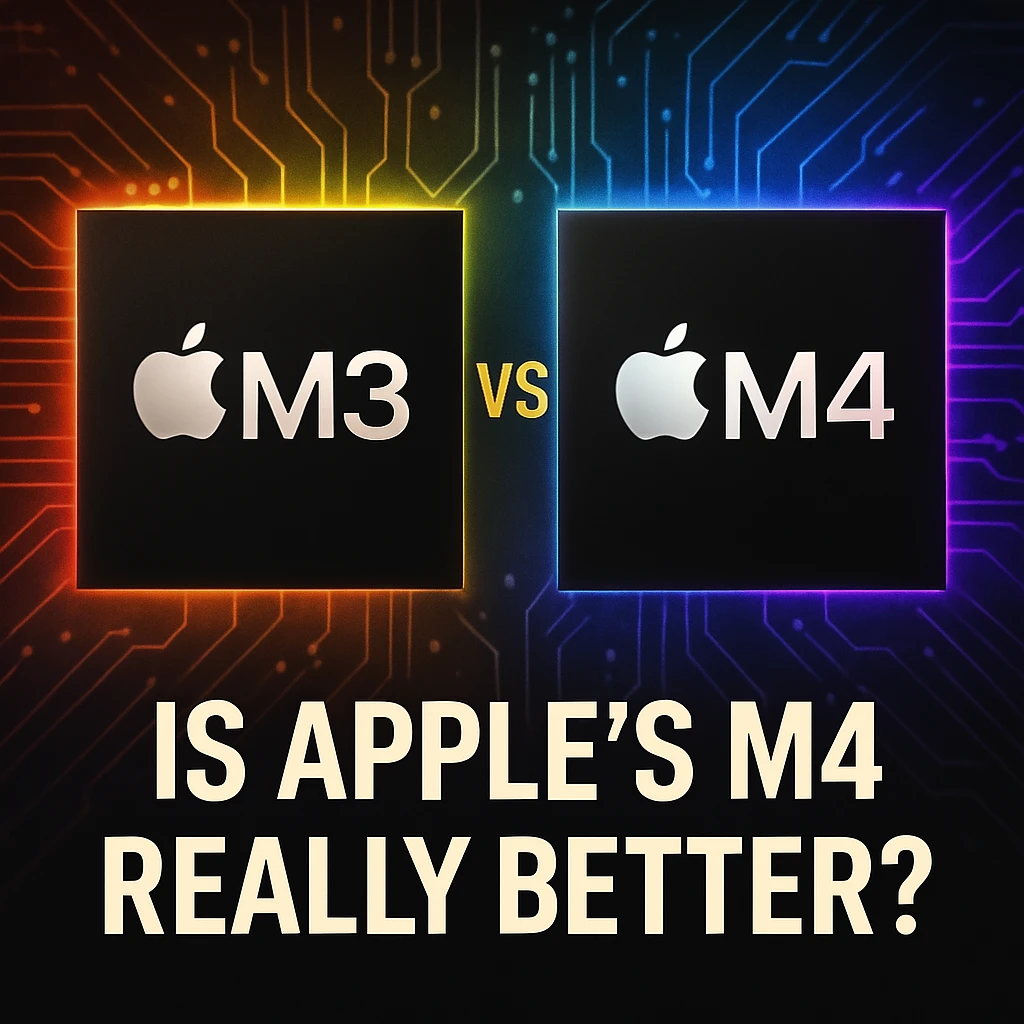Apple’s new M4 chip has arrived, and everyone’s buzzing about how it compares to the M3. Sure, the M4 is quicker, but does that mean your day-to-day experience will feel any different? Well, it might, but that largely depends on what exactly you’re doing with your Mac.
Let’s dig into how these two chips stack up in actual performance, real-world use, and against competitors to help you decide if the M4 is worth your money.
Spoiler alert: If you’re regularly editing high-res videos, working with 3D graphics, or running heavy-duty apps, you’ll appreciate the extra muscle in the M4. But if you’re mostly browsing the web, streaming movies, and checking emails, the upgrade might not seem so impressive.
M1 to M4: Apple’s silicon evolution explained
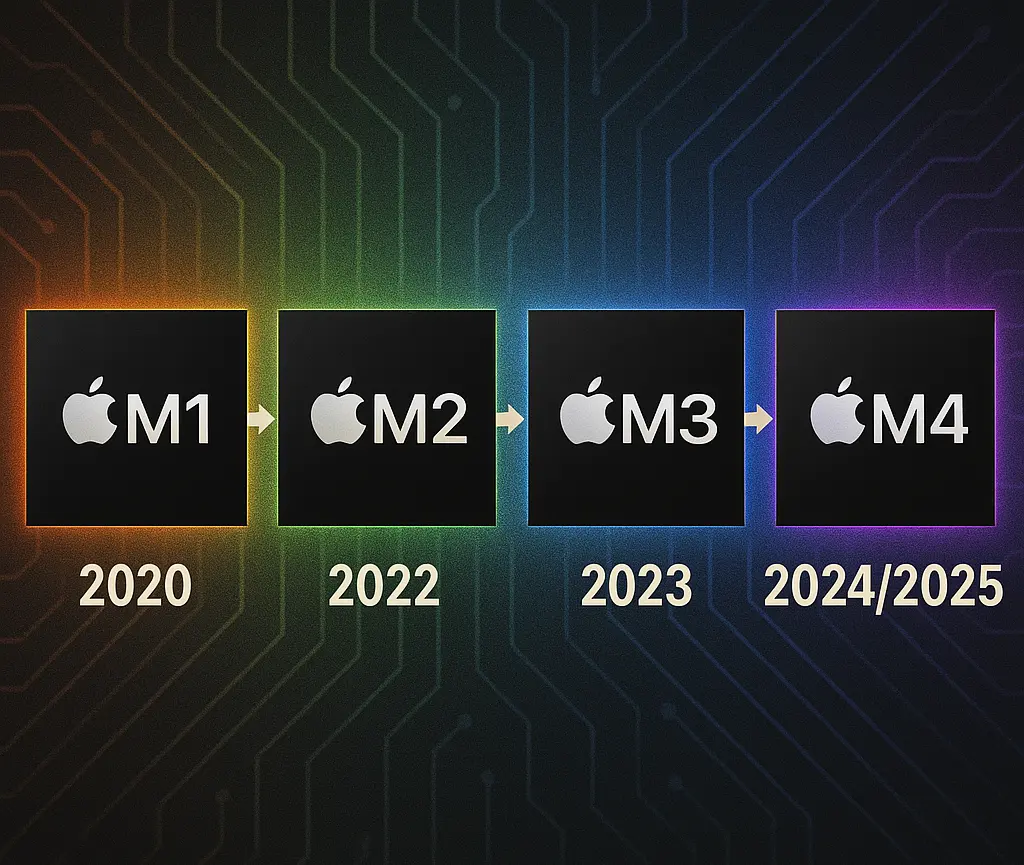
If you’re following Apple silicon closely, you’ve noticed each generation takes a meaningful performance leap forward. Let’s explore each chip’s features to understand how they differ and why that matters to you.
M1 (2020) – Changing everything:
Apple’s M1 chip changed everything you knew about Macs in a single bold move. Once you upgraded, performance skyrocketed instantly, leaving Intel-based MacBooks feeling slow and outdated overnight. Tasks became effortless, battery life jumped to levels you’d never experienced, and your device ran quietly.
Switching to an M1 Mac made everyday computing feel fresh, smoother, and noticeably more responsive. Your device no longer heated up under pressure, staying cool even during demanding workloads or multitasking. This chip sets an extremely high bar, redefining your expectations for future Mac upgrades altogether.
M2 (2022) – Subtle yet effective improvements:
The M2 chip brought solid upgrades, building steadily on what the M1 had already accomplished. You noticed about 10-20% quicker CPU performance and roughly 35% improved graphics capability overall. Apps opened a bit faster, graphics felt smoother, and the extra memory helped with tougher workloads.
Still, transitioning from M1 to M2 felt more like fine-tuning than reinventing the computing experience. If you had the original M1, upgrading likely didn’t seem crucial—your existing setup remained powerful enough. Essentially, M2 kept Apple comfortably ahead, but it wasn’t the dramatic jump you’d experienced earlier.
M3 (2023) – Redefining excellence clearly:
The M3 marked Apple’s largest performance jump since the original M1, especially in graphics capabilities. Built using an advanced 3nm process, it shared design updates from the iPhone’s A17 Pro chip. This allowed the CPU to perform tasks faster and handle your workloads with greater power efficiency.
With M3, Apple also introduced a GPU upgrade featuring Dynamic Caching and hardware ray tracing technology. These changes provided smoother graphics, allowing Macs to handle games and graphic-heavy tasks more comfortably. If you skipped the M2 upgrade, moving directly to M3 gave you noticeable performance improvements overall.
M4 (2024/2025) – Evolution, not revolution:
The M4 arrives with upgrades more subtle than revolutionary, especially compared to its immediate predecessor. If you’re moving from an M1 or an Intel Mac, the difference will definitely feel substantial. But for current M3 users, improvements like faster speeds and better efficiency will seem more incremental.
Apple’s marketing highlights this moderate progress by comparing the M4 mostly against the older M1 chip. This suggests the brand itself recognizes the modest improvements between its latest two generations of silicon. While the M4 is undeniably superior, you’re likely seeing the diminishing returns typical of mature chip architectures.
Apple M3 vs M4 chip: Feature-based comparison
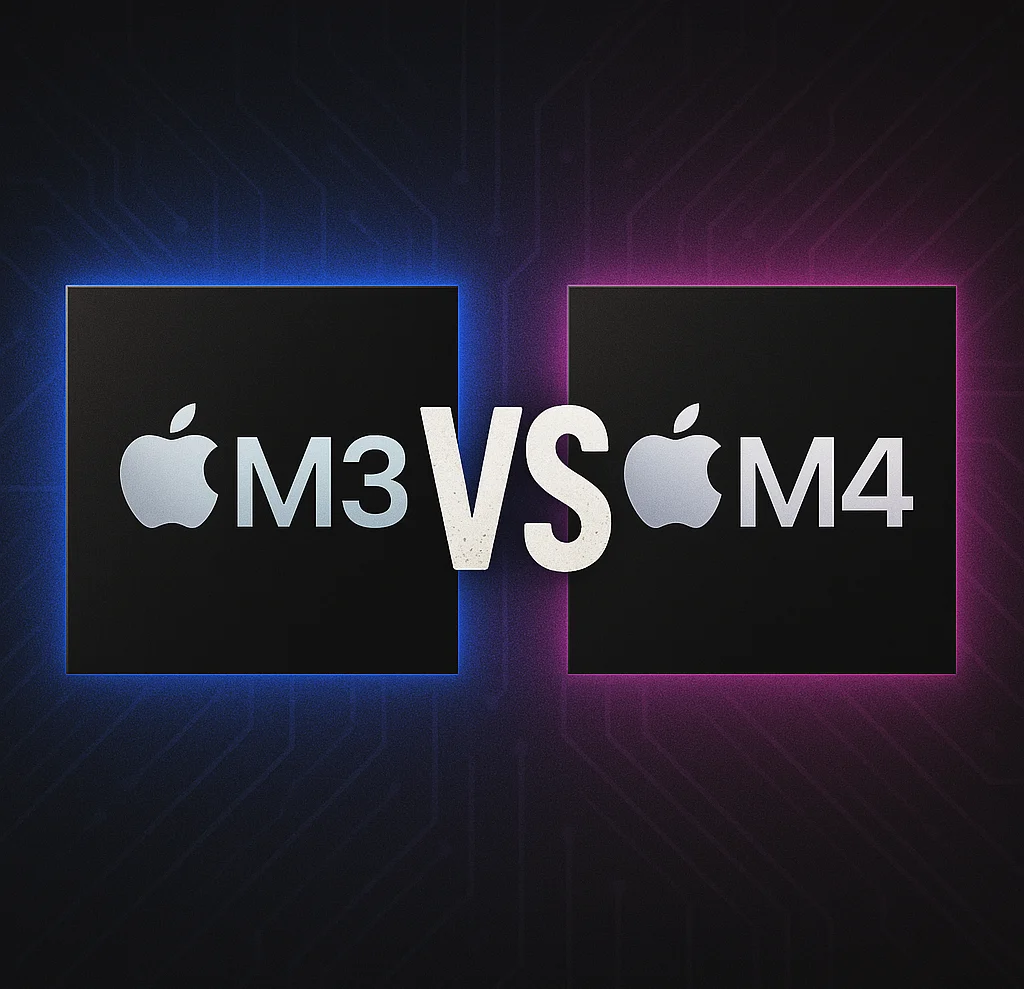
Wondering if the Apple M4 chip is a genuine upgrade from your current M3? Let’s go through a feature-by-feature comparison to evaluate if it’s truly worth your consideration.
Chip architecture and transistors:
Apple’s M4 chip refines the foundation set by its predecessor, the M3, using TSMC’s advanced 3nm (N3E) manufacturing process. With about 3 billion additional transistors compared to M3, the M4 gains a clear technical advantage. These extra transistors translate into more cache, increased efficiency cores, and modest improvements in clock speeds.
However, if you’re expecting a complete redesign from M3 to M4, that’s not what you’re getting here. Instead, Apple chose incremental improvements, enhancing performance and efficiency without rewriting the chip’s fundamental architecture. Think of M4 as Apple’s way of fine-tuning the successful formula introduced with M3, rather than reinventing it entirely.
Improved GPU with ray tracing:
The GPU improvements from Apple’s M3 to M4 chip center around faster ray tracing engine in M4. You’ll notice that games and professional graphics apps feel more responsive, especially with realistic lighting and reflections. If you often explore advanced graphics features, this upgraded ray-tracing engine clearly boosts your experience.
However, if your daily tasks don’t involve intensive graphics, the M4’s GPU upgrade might feel subtle. While it’s exciting to have hardware capable of impressive visuals, most casual users won’t actively experience the difference. For you, this GPU advancement serves mostly as an interesting tech detail rather than a necessary feature.
Neural engine and AI readiness:
Both M3 and M4 come with a 16-core Neural Engine, yet the M4 packs more raw power. With the ability to manage up to 38 trillion operations per second, it easily doubles M3’s capabilities. This extra muscle means your Mac handles machine learning tasks, like image recognition or natural language processing, with greater ease.
Where the M4 truly shines is in its readiness for upcoming AI-driven macOS features. If you’re a developer or simply enthusiastic about AI, you’ll appreciate how well M4 supports next-generation applications. While M3 is sufficient today, investing in M4 ensures your Mac stays capable as more demanding AI tools arrive.
Memory and bandwidth:
The M4 chip offers clear memory improvements over the M3, especially for data-heavy tasks. It upgrades to faster LPDDR5X unified memory compared to LPDDR5 used in the M3, boosting memory bandwidth by about 20%. For you, this means noticeably quicker performance when editing large photos, handling complex video projects, or running multiple demanding apps at once.
Moreover, the base version of the M4 chip supports up to 24GB or even 32GB of unified memory. This matches or surpasses the memory capacity of the M3, with Pro and Max versions of M4 supporting even higher amounts. So, whether you’re dealing with massive databases or juggling numerous apps simultaneously, the M4 provides extra breathing room for smoother multitasking.
Display and media engines
Apple’s display engine in the M4 chip received notable upgrades from the previous M3 version. With M4, your MacBook Air or Pro can easily run two external monitors alongside its internal screen. This upgrade makes a real difference for power users who require efficient, multi-monitor workstations on MacBooks.
The media engine in the M4 chip also benefits from improvements aimed at heavy-duty tasks. You can smoothly edit 4K or 8K videos without stressing about codec compatibility or processing delays. While average users may overlook this upgrade, professionals will value the effortless high-resolution video workflow.
Apple M3 vs M4 chip: Performance face-off
The competition between Apple’s M3 and M4 chips is heating up, and performance is key. Let’s see how these two processors compare, and what that means for your daily use.
CPU performance:
When it comes to CPU performance, the M4 gives you a clear, noticeable advantage. Its hybrid processor includes 8–10 cores, featuring 4 high-performance and 4–6 efficiency cores. These cores run at slightly higher clock speeds, giving M4 about 25–30% better multi-core results.
During heavy multitasking or demanding workloads, you’ll feel the difference M4’s extra processing power provides. However, if your daily routine involves typical tasks like email or browsing, both chips perform similarly. Even though the M4 packs more horsepower, the M3 is already impressively quick for everyday activities.
GPU performance:
Both M3 and M4 include Apple’s integrated graphics, yet the M4 adds extra refinement and efficiency. With up to 10 GPU cores, similar to the M3, the M4 runs roughly 20% quicker. You’ll notice smoother frame rates in gaming and improved animations, though the difference isn’t dramatic.
If you’re big on gaming or 3D modeling, the upgraded ray-tracing capabilities make M4 appealing. It provides better visuals and rendering speeds, giving your graphics tasks some extra breathing room. But if your usage stays casual, the M3 GPU will comfortably meet your daily requirements.
AI and machine learning (neural engine):
The M4 chip doubles the neural engine’s capacity, handling twice the operations per second versus M3. On paper, that’s an exciting leap for AI features like Siri and smarter photo processing. But for daily use, you’ll barely notice—the M3 already handles AI tasks without breaking sweat.
If you’re heavily into specialized AI apps, you’ll notice M4’s extra power right away. For everyone else, the M4’s neural engine feels more like a smart investment for tomorrow’s tasks. Impressive as it is, the chip’s true AI capabilities will matter more down the road.
Benchmark numbers:
Benchmark numbers reveal the M4 chip outperforms the M3 by roughly 20–30% in CPU testing. You’ll also notice a similar leap in graphics performance, making the upgrade somewhat appealing. These improved scores confirm the M4 is genuinely faster, especially under heavy workloads like compiling code.
Yet, despite these enhanced numbers, you might not perceive significant gains in daily usage. Tasks like casual web browsing or document editing won’t feel noticeably quicker with an M4 upgrade. Ultimately, the advantage of M4 lies mainly in intensive tasks rather than routine activities you perform.
Thermals and heat management:
When comparing the Apple M3 and M4 chips, you’ll notice distinct thermal performance improvements with M4. Thanks to architectural refinements and its advanced 3nm manufacturing process, M4 handles workloads more efficiently. As a result, your device stays cooler, using less power even during heavy tasks like extended video renders.
For devices without fans, like your MacBook Air, this efficiency becomes even more noticeable. The M4 chip maintains high performance longer, delaying the thermal throttling you’d typically see with M3. So, if you’re running demanding applications, M4 keeps performance steadier and your laptop comfortably cool.
Battery life and efficiency:
Battery life has always been Apple silicon’s strong point, and the M4 pushes this further. With the M4, your MacBook can squeeze out an extra hour during web browsing or video playback. If you’re upgrading from the M3, you’ll notice tasks wrapping up sooner without draining extra battery.
However, the difference isn’t massive—think incremental improvement rather than a dramatic leap forward. The M3 already delivered solid battery performance, but the M4 takes it a subtle step ahead. If longer unplugged productivity matters to you, the M4 is worth the modest upgrade.
Which applications and use-cases are suitable for M3 and M4 chips?
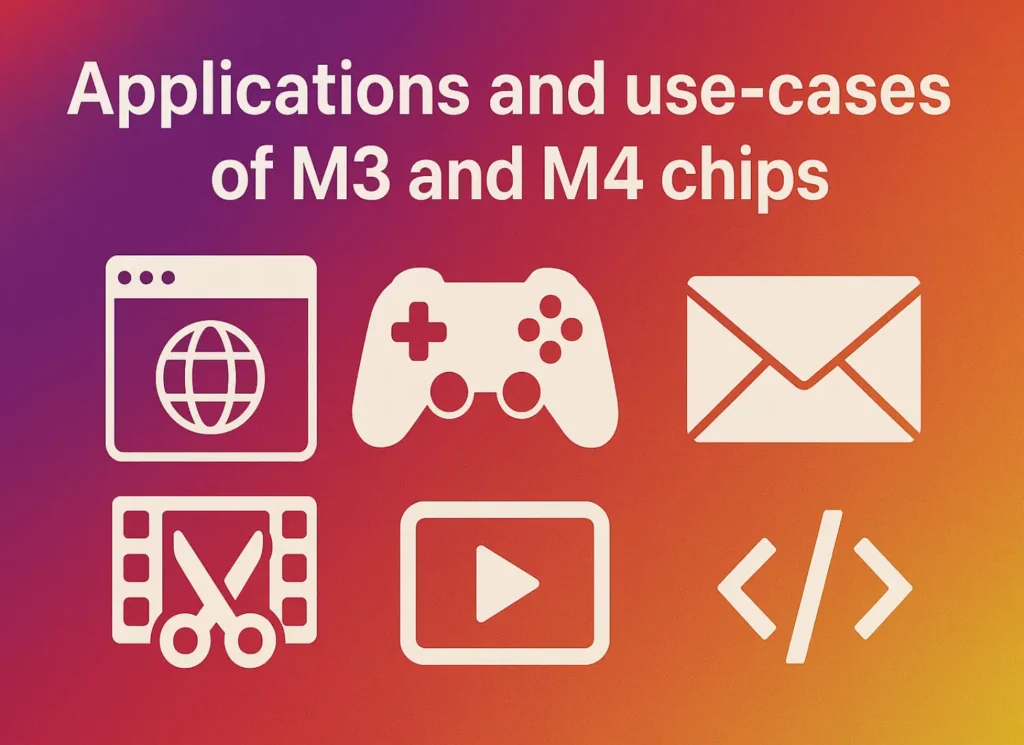
Both Apple’s M3 and M4 chips offer smooth and responsive performance for everyday computing tasks. Whether you browse the web, edit documents, or stream videos, either chip meets typical consumer needs easily. However, certain intensive workloads and specialized tasks can benefit more noticeably from M4’s additional processing power.
Casual web browsing and email management:
For basic internet browsing and handling emails, the M3 provides ample speed and responsiveness daily. You’ll notice webpages load instantly and emails pop up quickly, ensuring your tasks flow smoothly. Opting for the M4 won’t noticeably boost your experience, as M3 already handles these tasks effortlessly.
Choosing the M4 specifically for casual tasks might feel like an unnecessary luxury, adding minimal value. In practical use, switching between M3 and M4 while doing regular web browsing or emails feels identical. Thus, if this represents your typical computing usage, the M3 perfectly meets your everyday needs already.
Streaming videos and entertainment:
Watching Netflix, YouTube, or other streaming platforms remains flawless on both M3 and M4 chips. You’ll enjoy clear playback, quick buffering, and consistent streaming performance, providing enjoyable viewing each time. M3 ensures videos load without delay, giving you a consistently satisfying entertainment experience.
Picking M4 exclusively for video streaming won’t deliver a noticeable improvement over the already capable M3. Both chips effortlessly handle streaming, providing virtually identical quality of experience and smooth playback. Therefore, if streaming content represents most of your usage, M3 meets your expectations comfortably.
Heavy multitasking with office applications:
When running heavy multitasking involving multiple office apps simultaneously, M4 begins to show its advantage clearly. If your workflow often includes numerous open browser tabs, large spreadsheets, presentations, and Zoom meetings simultaneously, M4 stays responsive longer. You’ll appreciate fewer lags or spinning cursors under heavy stress.
Still, if your multitasking remains within reasonable limits, M3 comfortably handles office work and remains responsive. It smoothly manages common workloads, maintaining productivity without noticeable delays even with moderately heavy tasks. The M4 chip’s benefits emerge primarily when your workload consistently tests the system’s multitasking boundaries.
Professional video editing and content creation:
For creative professionals regularly editing high-resolution videos, the M4 chip significantly enhances rendering and exporting speeds. Tasks such as exporting 4K videos that took longer on the M3 noticeably reduced completion time with M4. Such efficiency gains can cumulatively save hours weekly, crucial for meeting professional deadlines and improving workflow.
If video editing forms an occasional hobby rather than professional duty, M3 already provides sufficient performance. While M4 delivers measurable speed improvements, casual or infrequent creators won’t find the gains particularly transformative. Thus, professional content creators will truly appreciate M4’s benefits; others may find M3 fully sufficient.
Intensive coding and development tasks
Developers compiling large codebases or running intensive simulations gain meaningful efficiency from upgrading to M4. Compilation tasks that previously took considerable time on the M3 complete noticeably faster using the M4 chip. This improved speed saves valuable minutes frequently, especially beneficial when rapid iterations or continuous builds matter.
Yet, for smaller coding projects or less frequent compiling needs, the M3 chip continues delivering satisfying responsiveness. Casual coders and developers handling lighter workloads won’t experience dramatically improved coding efficiency by upgrading. Hence, consider your coding intensity and frequency carefully when evaluating potential benefits of moving to M4.
Gaming and graphics applications:
Though Macs aren’t dedicated gaming machines, casual gaming sees slight frame rate boosts with M4 chips. Gaming sessions involving demanding graphics experience smoother performance and reduced frame drops compared to M3-powered devices. If gaming or graphics-intensive applications are essential parts of your Mac experience, these incremental improvements might be worthwhile.
However, for casual gamers or infrequent graphics applications users, the M3 already offers satisfying visual performance. M4’s modest frame rate improvements may go unnoticed unless your tasks consistently push graphical limits. For serious gaming, dedicated gaming setups still outperform both M3 and M4 Macs by significant margins.
Sustained performance under thermal load:
Performing tasks continuously for extended periods—like editing hundreds of RAW photos—highlights M4’s superior thermal management capabilities. The M4 chip maintains its top speed and responsiveness longer than the M3, reducing noticeable slowdowns and lag. You’ll especially appreciate less throttling, cooler surfaces, and quieter operation during extended intensive use periods.
For everyday or intermittent intensive tasks, M3 typically delivers adequate performance without pronounced thermal issues. Thermal throttling rarely becomes a real concern unless you frequently push the Mac beyond normal computing scenarios. Consider M4 specifically if prolonged intensive computing sessions characterize your routine.
Extended battery life for mobile productivity:
Mobile users regularly working unplugged might slightly prefer the battery-life improvements offered by the M4 chip. You could expect one to two extra hours of productivity per charge compared to a similar M3-equipped MacBook. These subtle efficiency gains matter when working remotely, traveling, or managing tasks without immediate access to charging points.
Still, M3 chip laptops already provide excellent battery life suitable for full-day mobile work scenarios. Unless your workflow consistently demands maximum battery endurance, the M3 typically satisfies your daily mobility requirements adequately. Opt for M4 specifically if incremental battery improvements meaningfully contribute to your typical mobile usage patterns.
How do Apple M3 and M4 chips compare with Intel & AMD processors?
Apple’s M3 and M4 chips have created serious competition for traditional Intel and AMD processors. Let’s break down how these chips compare so you can see what fits your needs best.
Apple is more efficient:
Apple’s M3 and M4 chips deliver impressive efficiency that leaves Intel and AMD playing catch-up. While competitors push hybrid cores and software tweaks, Apple already offers cooler, quieter computing experiences. You’ll find MacBooks running longer and smoother, because Apple chips do more with every watt used.
The M4 further stretches Apple’s lead, becoming one of the most efficient laptop chips ever created. If you prefer laptops that stay cool and quiet, Apple gives you a clear advantage. Intel and AMD keep improving, yet Apple remains unmatched for performance at minimal power usage.
Raw computing power:
Apple’s M3 and M4 chips offer impressive computing muscle while sipping minimal electrical power. When you’re handling single-thread tasks, the M4’s CPU matches or surpasses top-tier Intel Core i7 performance. Even AMD’s powerful Ryzen 7 and 9 processors find themselves competing closely with Apple’s newest silicon designs.
On multi-core tasks, your Mac Mini equipped with an M4 chip punches above its expected capability. Apple’s advanced M4 Pro and Max versions can even surpass desktop CPUs from Intel and AMD. Sure, high-core Intel and AMD chips still lead raw benchmarks—but they require enormous cooling systems.
Graphics and gaming:
Apple’s integrated GPUs in the M3 and M4 are genuinely impressive for built-in graphics chips. If you’re into professional content creation, Apple’s solution competes strongly against Intel and AMD offerings. Especially in tasks like video editing and 3D rendering, Apple chips often edge past their rivals.
However, if gaming drives your choices, you’ll notice discrete GPUs from NVIDIA and AMD dominate. Apple’s integrated graphics can run modern games decently, yet dedicated graphics cards offer superior performance overall. So, while Apple excels in efficient graphics performance, gamers still find the highest FPS elsewhere.
AI features:
Apple’s M3 and M4 chips lead the competition by embedding powerful neural engines right on-chip. While Intel and AMD have begun adding specialized AI cores, Apple’s integration remains superior and mature. When editing photos or using voice assistants, your Mac runs smoother compared to most traditional PCs.
Although Intel’s latest CPUs feature built-in AI cores, their implementation feels newer and less refined. AMD is catching up as well, yet their AI features aren’t as seamlessly embedded as Apple’s. Choosing M3 or M4 gives you a noticeable advantage in daily AI-driven tasks over typical processors.
Apple’s ecosystem advantage:
Apple’s ecosystem offers you an integration level Intel and AMD simply can’t match today. With macOS optimized specifically for Apple silicon, your Mac feels cohesive and performance remains consistently smooth. Each app is refined for M3 and M4 chips, making tasks quicker on Mac than Windows.
By comparison, Intel and AMD must serve countless devices, limiting their hardware-software tuning capabilities. While these chips handle versatile tasks, the fine-tuned user experience you get from Apple remains unmatched. Choosing an M3 or M4 chip ensures hardware and software speak the same language seamlessly.
Intel and AMD are catching up:
Intel and AMD are steadily closing in on Apple’s dominant position in ultrathin laptop processors. Intel’s recent shift to hybrid core designs, mixing powerful and efficient cores, mirrors Apple’s strategy. This change allowed Intel to boost multi-threaded tasks, helping their chips handle workloads more smoothly.
Meanwhile, AMD isn’t sitting still either, pushing ahead with chiplets and innovative 3D-stacked caches. Their latest Ryzen mobile processors offer stronger integrated graphics and improved efficiency, narrowing Apple’s advantage further. Though Apple’s M3 and M4 still hold the edge overall, the gap shrinks with each generation.
Which Apple devices support M3 and M4 chips?

Apple’s latest M3 and M4 chips offer next-level performance across various devices. Here’s a quick rundown of which Apple products feature these powerful chips:
Apple products with M3 Chip:
- MacBook Pro (Screen size: 14-inch, Launch date: November, 2023): This MacBook Pro handles graphic-heavy tasks with ease thanks to its robust 10-core GPU.
- MacBook Air (Screen sizes: 13-inch & 15-inch, Launch date: March, 2024): With choices between 8- and 10-core GPUs, these models are great for balancing mobility with performance.
- iMac (Screen size: 24-inch, Launch date: 2023): The iMac delivers enhanced graphics performance through its advanced 10-core GPU.
- iPad Air (Generation: 7th, Launch date: 2025): This iPad Air offers notable performance gains via its 9-core GPU, suitable for daily tasks and creative apps.
Apple products with M4 Chip:
- iPad Pro (Generation: 7th, Launch date: May, 2024): The upgraded iPad Pro debuts the M4 chip alongside stunning OLED displays for better visuals.
- MacBook Pro (Screen sizes: 14-inch & 16-inch, Launch date: October, 2024): Featuring M4 Pro and M4 Max chip options, these MacBook Pros excel in heavy-duty professional tasks.
- MacBook Air (Screen sizes: 13-inch & 15-inch, Launch date: March, 2025): Now featuring the M4 chip, these MacBook Air models deliver strong performance in a sleek design.
- Mac mini (Launch date: 2024): The compact Mac mini now packs impressive power, courtesy of the M4 chip.
- iMac (Screen size: 24-inch, Launch date: November, 2024): Updated with the M4 chip, this iMac boosts your desktop performance noticeably.
- Mac Studio (Launch date: March, 2025): Touted as Apple’s highest-performing Mac, offering M4 Max and advanced M3 Ultra chips.
Is the M4 chip more costly than M3?
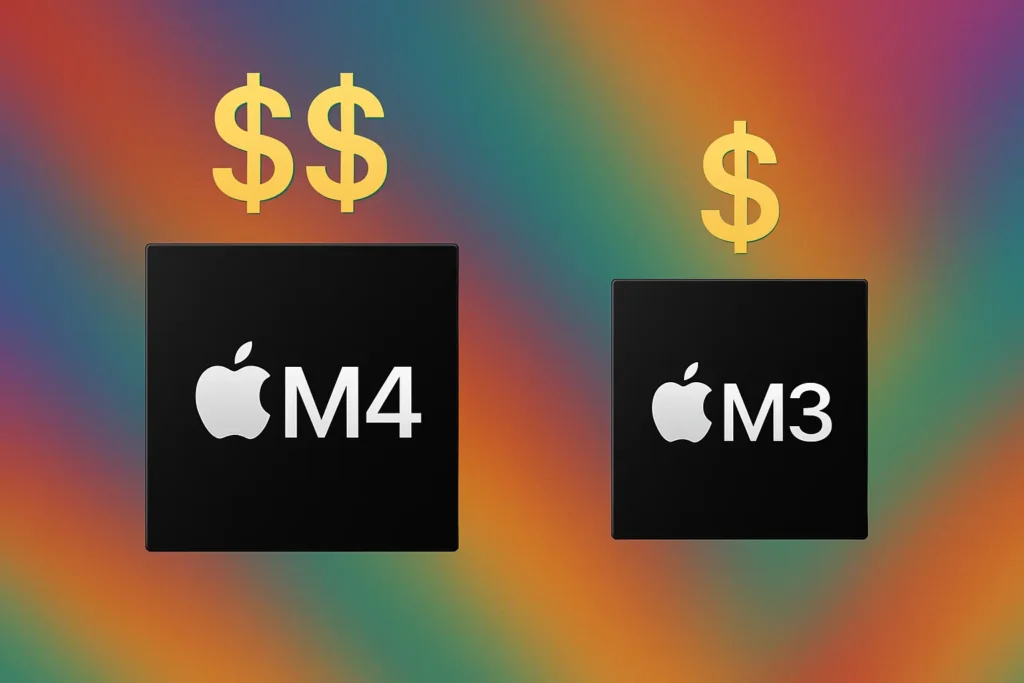
The price difference between Apple’s M3 and M4 chips isn’t consistent across all device categories. Depending on the gadget you choose, opting for the newer M4 may cost more or less. Your decision on which chip to buy should consider specific models and their price tags carefully.
If you’re considering the 14-inch MacBook Pro, expect to pay extra for the M4 chip. Choosing this latest model will cost you $1,599 compared to the M3’s lower $1,299 cost. You pay a premium, but Apple justifies this by offering better features and higher performance levels.
However, the opposite is true with the 15-inch MacBook Air models using these two chips. Selecting the M4-equipped Air will surprisingly save you around $100 versus the previous M3 edition. Thus, you can upgrade your performance and still manage to keep a little extra cash.
Then there’s the Mac Mini, where Apple’s pricing remains stable between both chip generations. With either the M3 or M4 inside, the Mini’s price remains at a constant $599 mark. Here, you gain improved capabilities from Apple without paying an extra dollar for the upgrade.
Final thoughts: Is M4 a genuine leap or just another upgrade?
Apple’s M4 offers clear improvements, but it’s still closer to refinement than total transformation. If you currently use the M3, upgrading to M4 won’t drastically change your everyday tasks. You’ll notice the gains mainly in specialized workloads rather than your typical daily computing routines.
Yet, incremental doesn’t equal insignificant—M4 genuinely boosts Apple’s dominance in power-efficient performance standards. Users coming from older models like M1 or Intel will notice substantial leaps in capability. While it’s no revolutionary breakthrough, the M4 remains another solid step forward in Apple’s chip progression.
